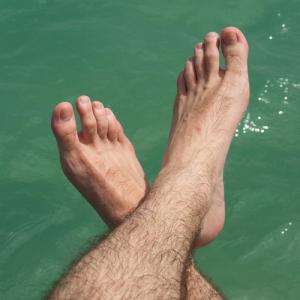Try tea tree oil to cure athlete’s foot
Q. What’s the best way to get rid of athlete’s foot?
As a victim of athlete’s foot, I’ve had a lot of experience battling that nasty nuisance, so I can add some personal notes on this subject. I’ve had the most success treating my athlete’s foot with an Australian remedy. I’ll get to that later.
Athlete’s foot is caused by tinea, a fungus that can also cause jock itch and ringworm. You can catch it from another person, from animals or wet surfaces such as the floors of public showers.
Athlete’s foot symptoms include dry skin, itching, burning, scaling, inflammation and blisters. If blisters break, tissue becomes exposed, and this can be painful.
Athlete's foot usually shows up between the toes, especially the last two toes. Tinea thrives on feet because they are usually in shoes, which are perfect for fungus - they are warm, dark and humid.
The fungus can spread on the feet. It can also travel to other parts of the body if you scratch your feet and then touch elsewhere.
Before attempting to treat what you think is athlete’s foot, you should have your feet examined by a doctor. Symptoms you assume are from athlete’s foot could be from eczema, psoriasis or other maladies such as a skin reaction to shoe dyes.
For a mild case of athlete’s foot, your doctor may recommend an over-the-counter or prescription preparation. There are antifungal sprays, powders, creams and lotions.
If you have a severe case of athlete’s foot, your doctor may prescribe an oral medication.
After the medication works, athlete’s foot recurs in some people because they are prone to get it. The tendency to get athlete’s foot repeatedly is a genetic condition.
This brings us to a remedy that works better than any I’ve tried since my first of many cases of athlete’s foot about 40 years ago. It’s tea tree oil. You can get it in health food stores.
Tea tree oil is an essential oil distilled from the leaves of Melaleuca alternifolia, an Australian plant. For many years, the leaves of the plant were used for treating cuts, burns and infections.
A randomized controlled trial examined the use of 25 percent tea tree oil solution, 50 percent tea tree oil solution, or placebo in 158 people with athlete's foot. After twice-daily applications for four weeks, the tea tree oil was found to be significantly more effective than placebo.
I have used many over-the-counter products on athlete’s foot. A few did not work at all. A few were effective after several weeks. I applied 100 percent tea tree oil twice a day and my athlete’s foot was gone in a week. I’ve continued to apply it once a day to prevent a recurrence.
Do not apply tea tree oil to your feet without consulting a physician. There are possible side effects that include allergic rash, redness, blistering, and itching. I experienced a mild burning sensation when I applied the undiluted tea tree oil, but had no other problems.
There are ways to prevent getting athlete’s foot. The best general advice is to keep your feet clean and dry. Here are some good specific tips:
• When you can, remove your shoes.
• Change your socks at least once daily.
• Avoid walking barefoot in public areas. Wear sandals or flip-flops in communal showers.
• Never borrow other people's shoes.
• Dry carefully between the toes after showering.
• Apply antifungal foot powder daily to feet and inside shoes.
• Wear shoes and socks made of natural materials that breathe.
• Don’t wear the same shoes two days in a row; give shoes a chance to dry out.
• Have a veterinarian check your pets for fungus.
















































